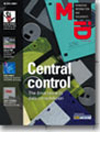
Cold Comfort
- Article 8 of 26
- M-iD, July 2004
Page 1 | Page 2 | Page 3 | Page 4 | All 4 Pages
"I've always been surprised that businesses haven't jumped onto these capabilities much more than they have done to date," says Craig Sullivan, director of product management at CRM vendor NetSuite. "Access to information is one of the biggest inefficiencies we see and hear about in SMEs [small and medium-sized enterprises]."
Kim Jasper, an IBM marketing manager, says he struggles to get his sales people to even mention COLD/ERM. "I often tell our sales people that report management and COLD are of very strong value to our customers. Just the ability for a customer-facing employee to retrieve stuff sent to customers in the last year or so is of immense value, not just to big enterprises but to SMEs as well."
"If you can archive all your information and invoices and statements on your system and retrieve them when your customer is on the phone," says Jasper, "you can give customers much higher quality of service - and with a total implementation and installation time of just a few days, it's an easy kill for IT managers and popular with end-users."
For those reasons, COLD/ERM implentations linked to CRM might be due for a second wind - and the concept of information lifecycle management (ILM) might be an important additional driver.
"What's new is thinking about how people can look at the content management lifecycle and see how things like reports are not standalone, but part of a lifecycle," argues David Gingell, vice president of marketing EMEA, at Documentum. "Information probably needs to be used in many ways and on many occasions. The ILM message talks about understanding the value of the information you're dealing with."
COLD/ERM systems offer two key benefits from an ILM perspective: the ability to retain data as dictated by legal and regulatory mandates but also to repurpose it as needed.
The ILM message - pick a storage medium to suit the data, depending on its position in the "information lifecycle" - fits nicely with COLD/ERM's integration into CRM: few customer statements are important after any more than a few months and can be archived to slower media, such as tape, avoiding the investment needed for faster storage media.
With EMC heavily promoting its disk-based write-once, read-many Centera system, companies are increasingly aware that archiving off reports for compliance purposes and then trying to access them in real-time through a COLD/ERM-enabled CRM application does not necessarily result in slowdowns in customer response.
In addition, many COLD/ERM vendors are working closely with storage systems suppliers to ensure that their systems can not only integrate with common storage management tools, but also to be able to bypass tools and write to the storage directly.
Although linkages to CRM systems from COLD/ERM systems have now been in existence for several years, the failure of organisations to benefit from CRM - and indeed in many cases to regard CRM as a failure - has meant that many are unwilling to sink more money into their CRM deployment to benefit from the integration.
Page 1 | Page 2 | Page 3 | Page 4 | All 4 Pages

